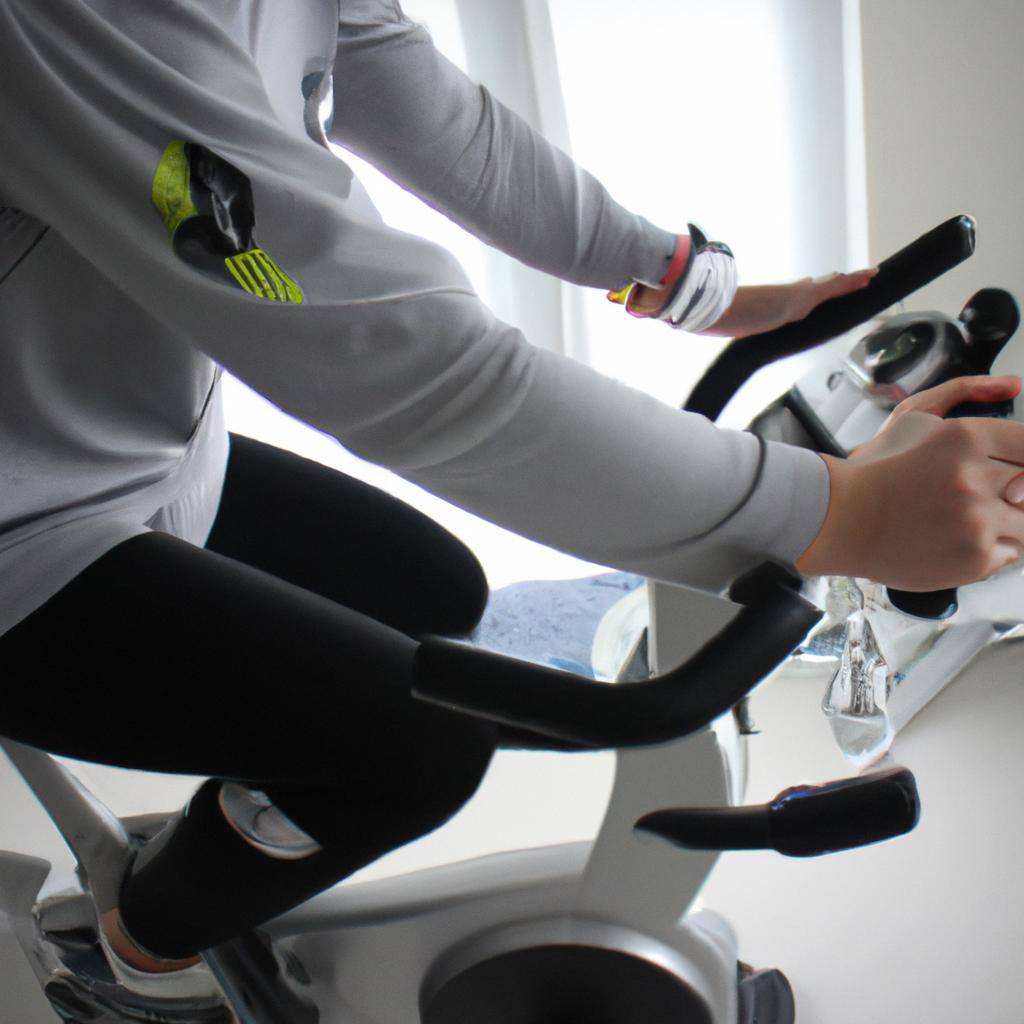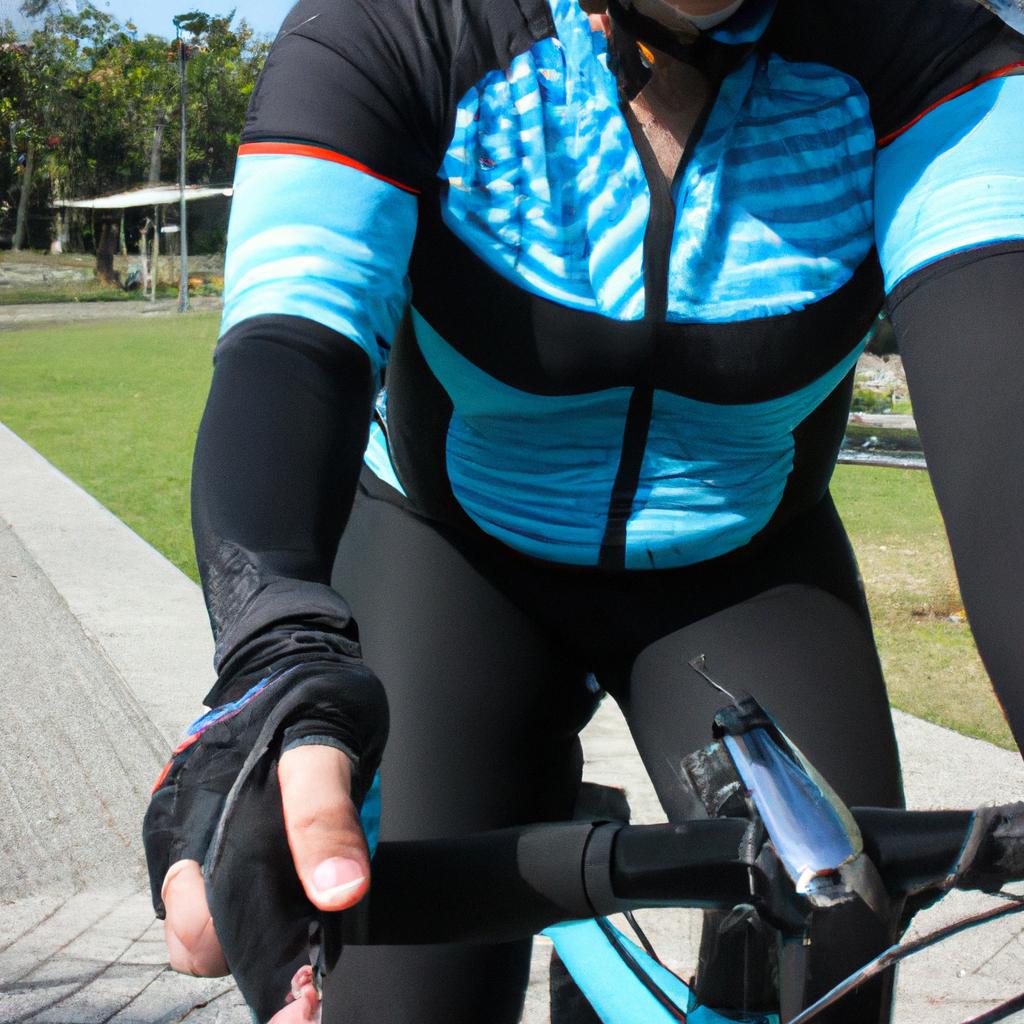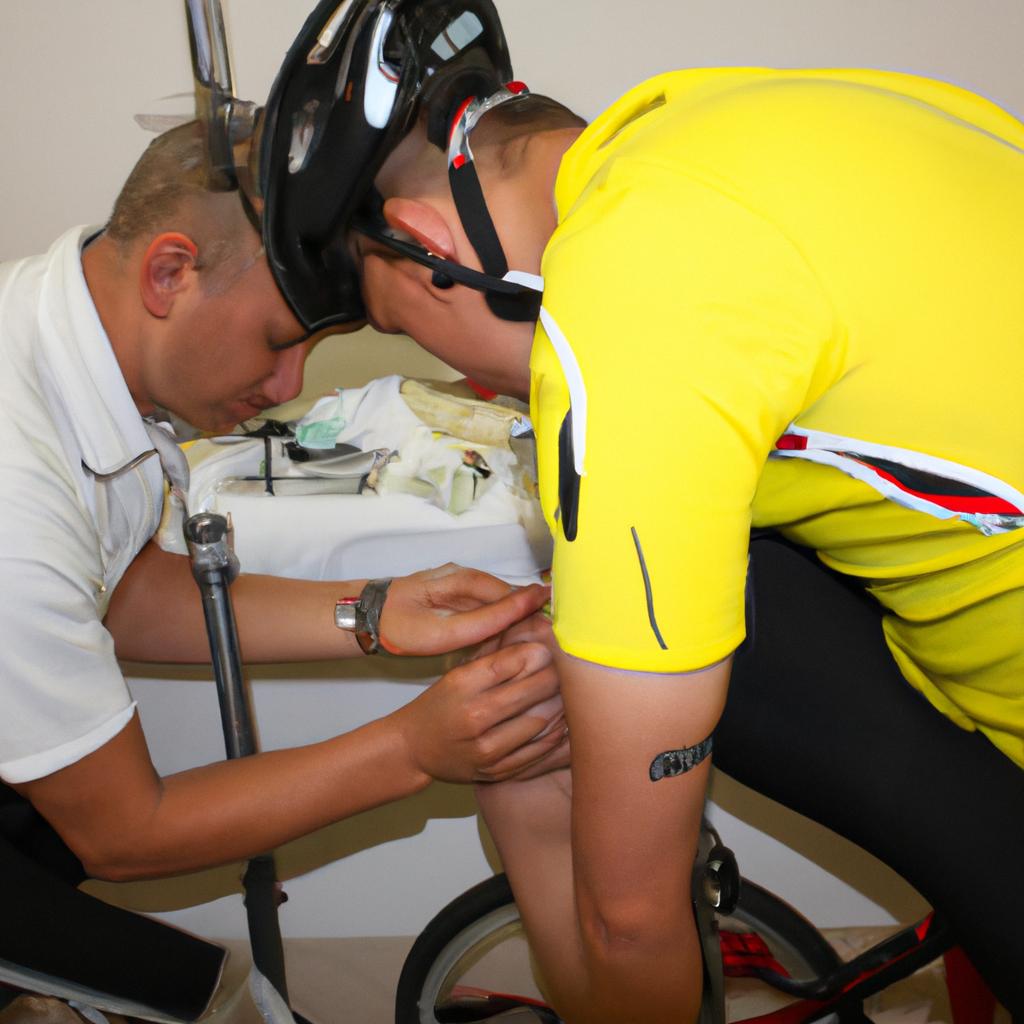Rehabilitation for Cycling Injuries: Sports Cycling : Informative

Cycling injuries can be a common occurrence for athletes and enthusiasts alike. Whether it is a professional cyclist training for a race or an amateur rider enjoying leisurely rides, the risk of injury is always present. One example that highlights the importance of rehabilitation in cycling injuries involves a hypothetical case study of a competitive cyclist who sustains a knee injury during intense training sessions. This article aims to delve into the topic of rehabilitation for cycling injuries specifically focusing on sports cycling, providing informative insights and recommendations based on academic research and expert opinions.
Rehabilitation plays a crucial role in addressing cycling injuries as it not only aids in recovery but also helps prevent future incidents. Cycling-related injuries are often attributed to factors such as overuse, improper bike fit, biomechanical imbalances, and accidents. The aforementioned case study illustrates how even seasoned cyclists can fall victim to these risks. To ensure effective rehabilitation, it becomes imperative to adopt an evidence-based approach that combines medical expertise with appropriate exercise protocols tailored to individual needs. By exploring various aspects of rehabilitation specific to sports cycling, this article seeks to equip readers with knowledge and strategies necessary for preventing and managing common cycling injuries effectively.
Common cycling injuries
Common Cycling Injuries
Imagine a scenario where Sarah, an avid cyclist, is training for a long-distance race. As she pushes herself to reach her goals, she suddenly experiences excruciating knee pain that hinders her performance and puts her cycling aspirations at risk. This case study highlights one of the many common cycling injuries faced by athletes like Sarah.
Cycling injuries can have significant implications on an athlete’s performance and overall well-being. Understanding these injuries is crucial in developing effective rehabilitation strategies. Here are some commonly encountered cycling injuries:
-
Knee Pain: One of the most prevalent cycling injuries, knee pain can be caused by various factors such as overuse, improper bike fit, or muscle imbalances. Cyclists often experience anterior knee pain (pain around the kneecap) or iliotibial band syndrome (ITBS), which affects the outer side of the knee.
-
Lower Back Pain: Prolonged periods of riding in a flexed position can lead to lower back pain among cyclists. Factors contributing to this discomfort include poor posture, weak core muscles, and inadequate bike setup.
-
Neck and Shoulder Strain: The repetitive motion involved in cycling can strain the neck and shoulder muscles. Cyclists may experience tightness or discomfort in these areas due to prolonged forward head positioning or excessive tension while gripping the handlebars.
-
Wrist and Hand Issues: Gripping the handlebars tightly for extended durations can result in wrist and hand problems such as carpal tunnel syndrome or ulnar neuropathy. These conditions may cause numbness, tingling sensations, or weakness in the hands.
To further illustrate the impact of these injuries on cyclists’ lives, consider the following table:
| Injury | Physical Symptoms | Emotional Impact |
|---|---|---|
| Knee Pain | Difficulty pedaling | Frustration and disappointment |
| Lower Back Pain | Limited mobility | Decreased confidence |
| Neck and Shoulder Strain | Stiffness and discomfort | Anxiety and stress |
| Wrist and Hand Issues | Numbness or weakness | Fear of losing control |
Understanding the common cycling injuries is imperative, but it is equally vital to explore their causes. In the subsequent section, we will delve into the factors that contribute to these injuries, providing valuable insights for prevention and rehabilitation strategies.
By examining the various cycling injuries athletes face, we can develop a comprehensive understanding of the physical challenges they encounter. This knowledge serves as a foundation for identifying effective rehabilitation methods tailored specifically to address each cyclist’s unique needs.
Causes of cycling injuries
Transitioning from the previous section on common cycling injuries, it is imperative to discuss the various causes of these injuries and how rehabilitation plays a crucial role in the recovery process. To illustrate this point, let us consider a hypothetical case study involving an avid cyclist named Mark who recently suffered a knee injury while out on a ride. Mark’s injury serves as a reminder that cycling can be physically demanding and poses risks that necessitate proper rehabilitation methods.
Rehabilitation for cycling injuries often involves a comprehensive approach aimed at addressing both physical and psychological aspects of recovery. Here are key elements commonly incorporated into rehabilitation programs:
-
Physical therapy: A structured program designed by healthcare professionals helps cyclists regain muscle strength, improve range of motion, and enhance overall flexibility. This may involve exercises targeting specific areas affected by the injury such as knees or shoulders.
-
Pain management techniques: Managing pain is vital during the recovery process to ensure optimal healing and prevent further complications. Techniques like ice therapy, heat therapy, transcutaneous electrical nerve stimulation (TENS), or non-steroidal anti-inflammatory drugs (NSAIDs) may be utilized based on individual needs.
-
Psychological support: Coping with an injury can be mentally challenging for athletes. Therefore, incorporating counseling or psychotherapy sessions within rehabilitation programs can help address any anxiety, depression, or fear related to returning to cycling after an injury.
-
Education and guidance: Providing cyclists with information about injury prevention strategies and safe training practices not only aids in their current recovery but also empowers them for future endeavors on the road.
To emphasize the significance of proper rehabilitation, we present a table showcasing statistics related to cycling injuries:
| Type of Injury | Frequency | Consequences |
|---|---|---|
| Fractures | 40% | Loss of mobility |
| Soft tissue | 35% | Chronic pain and discomfort |
| Head injuries | 15% | Cognitive impairments, risk of concussions |
| Spinal injuries | 10% | Paralysis or limited mobility |
Understanding the causes of cycling injuries and implementing effective rehabilitation strategies is crucial in promoting a safe and successful return to cycling. By focusing on physical therapy, pain management, psychological support, and education, individuals like Mark can recover fully from their injuries and regain confidence on their bikes. As we move forward into the subsequent section about prevention strategies for cycling injuries, it becomes evident that proactive measures are essential to ensure long-term cyclist well-being.
[Transition sentence: Moving onto the next section about prevention strategies for cycling injuries…]
Prevention strategies for cycling injuries
Causes of cycling injuries can vary, ranging from external factors such as road conditions to intrinsic factors like improper technique or muscle imbalances. Understanding these causes is crucial in developing effective prevention strategies and implementing appropriate rehabilitation methods for cyclists who have sustained injuries.
For instance, consider the case of a cyclist named Alex who experienced knee pain after increasing their training intensity. This serves as an example of how overuse and sudden changes in activity levels can contribute to cycling injuries. It highlights the importance of gradually progressing training volume and intensity to avoid excessive stress on vulnerable body structures.
To address and prevent cycling injuries effectively, it is essential to implement the following strategies:
- Proper bike fit: Ensuring that the bicycle fits the rider’s body proportions and biomechanics can minimize unnecessary strain on joints and muscles.
- Technique optimization: Educating cyclists about proper pedaling mechanics, body positioning, and weight distribution helps reduce undue stress on specific areas prone to injury.
- Strength and flexibility training: Incorporating exercises targeting core stability, lower limb strength, and flexibility assists in improving muscular imbalances while enhancing overall performance.
- Recovery practices: Encouraging adequate rest periods between intense sessions allows for tissue repair and prevents overuse injuries caused by repetitive motion.
In addition to these strategies, recognizing common cycling-related injuries can aid in early detection and prompt intervention. The table below provides examples of signs and symptoms associated with some prevalent cycling injuries:
| Injury | Signs & Symptoms |
|---|---|
| Patellofemoral Pain | Anterior knee pain aggravated by prolonged sitting or biking |
| Achilles Tendinopathy | Heel pain worsened during push-off phase |
| Lower Back Pain | Stiffness or discomfort in the lumbar region |
| Cervical Strain | Neck pain exacerbated by prolonged neck extension |
Understanding the underlying causes of cycling injuries enables practitioners to develop comprehensive rehabilitation programs tailored to each cyclist’s needs. By implementing appropriate prevention strategies and promptly addressing potential issues, cyclists can enjoy the sport while minimizing the risk of injury.
Moving forward, we will explore the signs and symptoms associated with cycling injuries, which will aid in early diagnosis and timely intervention.
Signs and symptoms of cycling injuries
Prevention strategies for cycling injuries can significantly reduce the risk of experiencing common cycling-related ailments. For instance, let’s consider the case of a hypothetical cyclist named Sarah. Sarah used to suffer from knee pain due to her intense cycling routine. However, by implementing effective prevention strategies, she was able to overcome this issue and continue enjoying her favorite sport.
One crucial aspect of preventing cycling injuries is proper bike fit. Ensuring that your bike is adjusted correctly according to your body measurements and riding style can minimize stress on joints and muscles. Additionally, regularly maintaining your bicycle by checking tire pressure, brakes, and gears will help prevent accidents caused by mechanical failures.
Furthermore, it is essential to gradually increase the intensity and duration of your rides rather than pushing yourself too hard too soon. This allows your body time to adapt and build strength while reducing the likelihood of overuse injuries such as tendinitis or shin splints.
To further enhance injury prevention efforts in sports cycling, here are some key recommendations:
- Always warm up before each ride with dynamic stretching exercises targeting major muscle groups.
- Incorporate cross-training activities into your fitness regimen to strengthen supporting muscles and improve overall flexibility.
- Use appropriate protective gear such as helmets, knee pads, elbow pads, and gloves.
- Stay hydrated during rides by drinking water at regular intervals.
Table: Common Cycling Injuries
| Injury | Symptoms | Treatment |
|---|---|---|
| Knee Pain | Swelling around the joint | Resting, icing, physical therapy |
| Lower Back Pain | Stiffness and discomfort | Stretching exercises |
| Neck Strain | Soreness in neck muscles | Massage therapy |
| Wrist Fracture | Severe pain | Immobilization through casting/splinting |
By following these preventive measures and understanding common cycling injuries along with their symptoms and treatments (as depicted in the table above), cyclists can enjoy their sport while minimizing the risk of injury.
Rehabilitation exercises for cycling injuries
Rehabilitation for Cycling Injuries: Sports Cycling
Signs and symptoms of cycling injuries can vary depending on the type and severity of the injury. One example is a cyclist who experiences sharp pain in their knee while pedaling, accompanied by swelling and difficulty bearing weight. These symptoms may indicate a common overuse injury called patellofemoral pain syndrome, which affects the kneecap and surrounding structures.
To aid in the recovery process, rehabilitation exercises are essential for cyclists with injuries. The following three paragraphs will outline some effective exercises that can help individuals regain strength and mobility after experiencing cycling-related injuries.
Firstly, incorporating stretching routines into a daily exercise regimen can significantly benefit injured cyclists. Stretching helps improve flexibility, reduces muscle tightness, and enhances joint range of motion. An effective stretch to target the quadriceps muscles involves standing upright and gently pulling one foot towards your buttocks until you feel a moderate stretch at the front of your thigh. Hold this position for 20-30 seconds before switching legs.
Secondly, strengthening exercises play a vital role in restoring balance and stability to injured areas. For instance, performing single-leg squats can help strengthen weak muscles around the knee joint. Start by standing on one leg with your arms extended forward for balance support. Slowly lower yourself into a squatting position while keeping your knee centered over your toes. Repeat this movement 10-15 times on each leg.
Thirdly, it is crucial to incorporate low-impact aerobic activities such as swimming or stationary biking into a rehabilitation program for cycling injuries. These activities promote cardiovascular fitness without placing excessive stress on recovering joints or muscles. Additionally, they allow individuals to maintain conditioning levels while gradually reintroducing cycling movements to their bodies.
The emotional toll of cycling injuries should not be overlooked either. Here is a bullet point list highlighting some common emotional challenges faced by athletes during rehabilitation:
- Frustration due to physical limitations
- Fear of reinjury or setbacks
- Anxiety about losing fitness levels
- Impatience with the recovery process
Furthermore, let’s consider a table that showcases the stages of emotional response during rehabilitation:
| Emotional Stage | Description |
|---|---|
| Denial | Initial disbelief and denial of the extent of the injury |
| Anger | Frustration and irritation towards the situation |
| Acceptance | Acknowledging the injury and focusing on recovery |
| Determination | Motivation to overcome obstacles and return to cycling |
In summary, effective rehabilitation for cycling injuries involves incorporating stretching routines, strengthening exercises, and low-impact aerobic activities into an individualized program. Furthermore, athletes may experience various emotional challenges throughout their rehabilitation journey. Understanding these emotions can help individuals navigate through each stage effectively.
Transitioning into our next section about “Tips for returning to cycling after an injury,” it is crucial to approach the reintegration process with patience and care, keeping in mind the progress made during rehabilitation.
Tips for returning to cycling after an injury
In the previous section, we discussed various rehabilitation exercises that can help cyclists recover from injuries. Now, let us delve deeper into some important tips to consider when returning to cycling after an injury.
To better understand these tips, let’s imagine a scenario where Sarah, an avid cyclist, sustains a knee injury while riding her bike. After undergoing necessary medical treatments and completing her rehabilitation exercises, she is eager to get back on the saddle. However, it is crucial for individuals like Sarah to approach their return cautiously in order to prevent reinjury and ensure a smooth transition back into cycling.
Tips for Returning to Cycling after an Injury
-
Gradual Progression: It is essential to start slowly and gradually increase the intensity and duration of your rides as you regain strength and mobility. Begin with shorter rides at a comfortable pace before gradually increasing both distance and speed over time.
-
Listen to Your Body: Pay attention to any pain or discomfort during your rides. If you experience any unusual sensations or excessive soreness, take it as a sign that you may need more time to fully recover. Ignoring these signals could potentially worsen the injury.
-
Proper Bike Fit: Ensure that your bike is properly fitted according to your body measurements and comfort level. A professional fitting session can be beneficial in preventing unnecessary strain on injured areas and reducing the risk of further complications.
-
Cross-Training: Engage in complementary activities such as swimming or yoga during your recovery phase. These low-impact exercises can improve overall fitness levels without placing excessive stress on specific injured muscles or joints.
Now that we have explored these helpful tips for returning safely to cycling after an injury, it is important to remember that each individual’s situation may vary. Consultation with a healthcare professional or physiotherapist who specializes in sports-related injuries would provide personalized guidance tailored specifically to your circumstances.
| Tip for Returning to Cycling after an Injury | |
|---|---|
| 1. | Gradual Progression |
| 2. | Listen to Your Body |
| 3. | Proper Bike Fit |
| 4. | Cross-Training |
By following these tips, you can ensure a smooth and successful return to cycling while minimizing the risk of reinjury or setbacks in your recovery journey.
Remember, patience and consistency are key when it comes to rehabilitation after cycling injuries. Take the time necessary to heal fully, gradually build back your fitness levels, and always prioritize safety on and off the bike.






